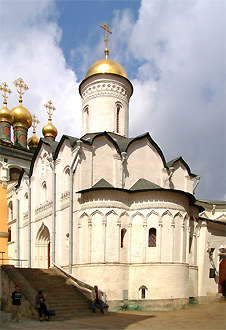|
 Dwarfed behind the Cathedral of the Assumption, this tiny church became the personal chapel of the Moscow Metropolitans and Patriarchs. It was built in 1484-86 by Pskov craftsmen, on the site of the original Church of the Deposition of the Robe, which perished in the Kremlin fire of 1473. The church commemorates the official recognition of the Moscow Metropolitan as Metropolitan of Kiev and all Russia, acknowledged in 1451 by Casimir IV, King of Poland and Lithuania.
Dwarfed behind the Cathedral of the Assumption, this tiny church became the personal chapel of the Moscow Metropolitans and Patriarchs. It was built in 1484-86 by Pskov craftsmen, on the site of the original Church of the Deposition of the Robe, which perished in the Kremlin fire of 1473. The church commemorates the official recognition of the Moscow Metropolitan as Metropolitan of Kiev and all Russia, acknowledged in 1451 by Casimir IV, King of Poland and Lithuania.
The church's name refers to the robe of the Virgin Mary, a prized relic which was held to have saved Constantinople from attackers on several occasions. When the city was threatened, the robe was paraded around the walls. In Moscow, an icon kept in this church was put to the same use.
During the 16th Century the church was reconstructed many times over, and a side chapel was added. Only after the 1917 Revolution did architects return this building to its original shape. Restoration work began in 1919 and lasted more than 40 years.
The church is small, light, and typical of the Moscow school, although there are Pskov features on the fasade. Inside the church, there are a number of frescoes devoted to the governing theme of the church - the Blessed Virgin. The artists Ivan Borisov, Semion Abramov, and Sidor Pospeyev depict scenes from the Virgin's life, while the fresco on the south wall depicts a miracle that occurred when Constantinople was saved from its enemies by the power of the robe.
The iconostasis, from 1627, is the work of 17th century artist Nazary Istomin Savin, one of the most famous icon-painters of his day.
Today the church houses a small exhibition of wooden sculptures from the 15th to 17th centuries. These include icons carved from wood, designed to be taken on long journeys. Such works are very rare examples of early folk art from the beginning of the Russian state and it is well worth paying them a visit.
|

 Dwarfed behind the Cathedral of the Assumption, this tiny church became the personal chapel of the Moscow Metropolitans and Patriarchs. It was built in 1484-86 by Pskov craftsmen, on the site of the original Church of the Deposition of the Robe, which perished in the Kremlin fire of 1473. The church commemorates the official recognition of the Moscow Metropolitan as Metropolitan of Kiev and all Russia, acknowledged in 1451 by Casimir IV, King of Poland and Lithuania.
Dwarfed behind the Cathedral of the Assumption, this tiny church became the personal chapel of the Moscow Metropolitans and Patriarchs. It was built in 1484-86 by Pskov craftsmen, on the site of the original Church of the Deposition of the Robe, which perished in the Kremlin fire of 1473. The church commemorates the official recognition of the Moscow Metropolitan as Metropolitan of Kiev and all Russia, acknowledged in 1451 by Casimir IV, King of Poland and Lithuania.